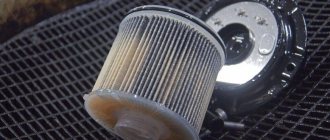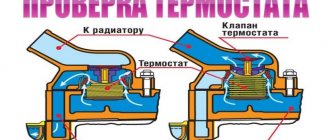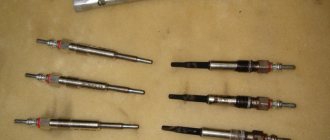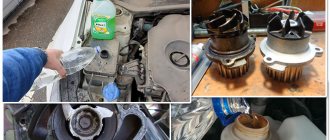Main elements and units
The operation of climate control is subject to a number of features. Its correct function in the car both in summer and winter is ensured by the presence of certain components.
The key components of the installation considered in this case combine the following:
- Air conditioner. Thanks to this mechanism, it is possible to maintain temperature and humidity at normal levels.
- Bake. Using this mechanism, you can collect engine coolant, which has previously warmed up to a certain level.
- A set of intakes along with an air duct system. They are responsible for the correct distribution of air and direct these flows to one or another area of the cabin.
- Fan. Promotes mixing of air flows inside the cabin.
- Thermal sensors. Used to measure air temperature in certain areas of the cabin.
- Furnace electric valves. The operation of the heat exchanger is suspended when heating is not necessary.
- Air intake curtains. To put them into operation, electric servos are used.
- Moisture level sensor. It is present in updated models, but was not used in old ones.
- Programmer-controller. Collects data from all available sensors and analyzes them, sends certain commands to actuators and units.
What is the operation of the unit based on?
The operating principle of such multifunctional equipment as climate control in a car in winter is subject to certain algorithms. They can be described as follows:
- The car owner sets a comfortable and suitable temperature in the cabin, for example, at +20 °.
- The climate control switches to auto mode.
- The controller starts up and analyzes the data from the temperature sensor. After that, it compares them with the parameter specified by the driver.
- If the temperature marks are higher than the set temperature, the air conditioner starts. In winter, this scenario is unlikely.
- If the temperature is below the set parameter, the solenoid valves open. Antifreeze gradually moves from the engine cooling system and then enters the radiator.
- Based on the set temperature and the actual temperature, the controller gives the command to turn on the fan at a particular power. In doing so, he takes into account the heating level of the coolant present in the furnace.
- If necessary, the recirculation module is started.
- The blowing speed is reduced by the controller when the set temperature is reached. From this moment on, the system goes into auto mode.
How to use climate control in a car in winter
You need to use climate control in your car in winter the same way as in summer - without restrictions.
The logically senseless switching on of the air conditioner to cool the interior in winter, when the temperature outside is below freezing, will be impossible due to the protection being triggered. And turning on the heater will not in any way affect the performance of the entire system, since the heater is designed to operate in winter. But to reduce the load on the climate control in winter and extend its service life, you can use a few simple tips.
- Be sure to change the cabin filter before winter. Especially if lately you notice that the windows have begun to fog up more often. The new cabin filter will not only improve interior ventilation, but will also allow you to turn on the heater less frequently to remove condensation from the inside of the car windows.
- Get anti-foggers. Inexpensive and easy-to-use products will help avoid the problem of systematic fogging of windows in regions with high air humidity.
- Lay down an absorbent mat. In winter, a lot of snow gets carried into the interior of the car on shoes. It melts and turns into moisture, which evaporates and subsequently likes to condense on the glass. An absorbent mat mitigates this phenomenon to some extent.
But first, it’s worth familiarizing yourself with how the air conditioner works as part of the car’s climate system.
Typical composition of AK:
- compressor, which is called the “heart” of the device. It is the most expensive air conditioner unit;
- a condenser designed to cool warm air. Works in tandem with a fan;
- a dehumidifier, whose tasks, together with the filtration system, include cleaning the refrigerant;
- piping system for circulating refrigerant in the system;
- a set of sensors that regulate the operation of the air conditioner in different modes;
- rubber gaskets and seals.
In addition to basic components, a car air conditioner can be equipped with additional functionality, for example, means of reporting the need to replace filters, refill refrigerant, or clean the condenser.
The air conditioning system requires periodic maintenance; the compressor, which ensures the functioning of all components, is most susceptible to breakdowns.
Simplified operation of a car air conditioner resembles the operating principle of a conventional household refrigerator. The working fluid is a refrigerant - a mixture of freon and oil dissolved in it. It is thanks to its performance characteristics that the warm air is cooled, and the oil provides lubrication of mechanisms and components subject to mechanical friction. When the air conditioner is turned on, the compressor begins to circulate refrigerant through the system
In addition, it provides little lubrication of all operating components and mechanisms, preventing their premature wear. When the device starts, the compressor is activated, which begins to compress the refrigerant, which is in a gaseous aggregate state. At the same time, it heats up and goes to the condenser, where it is cooled. The fan helps him in this, and when the car is moving, the oncoming flow of air also helps.
When cooled, the refrigerant changes from a gaseous to a liquid state. In the dryer, it gets rid of contaminants, including compressor wear, and goes to the thermostatic valve. Here it turns into a gaseous state and at the same time is greatly cooled, and in the evaporator it cools the air, which is supplied by a fan to the cabin. After the evaporator, the freon goes back to the compressor, the circle is closed.
So, we have already found out that even in the most severe frosts, it is periodically tedious to turn on the car air conditioner. The question here is different - many models of the latest generations are equipped with a protection function against switching on at certain temperatures. In this case, checking the operation of the air conditioner in the car in winter will be problematic - in frosty conditions you will have to look for a warm box and start the AK in such greenhouse conditions.
If there is no such restriction, there is no need to worry about the performance of the device, but there are several important nuances that you should know. In particular, it is necessary to use the internal circulation mode, in which air is taken not from the engine compartment, but from the passenger compartment, where the temperature is usually higher than outside.
You should not turn on the AC immediately after starting the engine - let it warm up, and only after that proceed with the maintenance of the air conditioning system. Many car owners do not practice starting the air conditioner in winter for reasons of fuel economy. This approach cannot be called reasonable - after 10-15 minutes of work, the consumption will increase slightly. Failure to follow this rule may result in you needing expensive repairs in the spring.
Tips for proper use
There are general recommendations and rules on how to use climate control in a car in winter. At the same time, climate control systems may differ in structure, depending on the model of the vehicle. In any case, for the device to become active, you need to press the start button - ON/OFF. Customization is allowed for both the entire interior space and individual areas.
On a note!
The adjustment step is 0.5°. The maximum difference between zones should not be more than 5 °.
As soon as the comfortable temperature is programmed, you must press the AUTO key. From this moment on, the equipment maintains the specified settings independently. The direction of air flow can be periodically changed using separate buttons.
Each of them sets the optimal airflow level. Standard models have 3 of these modes:
- blowing the head and foot area;
- windshield blower;
- blowing your feet.
You can also find more advanced models on the market that offer more useful options. You can familiarize yourself with them by referring to the user manual.
Attention!
It is better to start the climate control 60 seconds after turning on the engine. It is recommended to turn it off 1 minute before turning off the engine.
Diagnostics is an important component of the effective operation of climate control equipment. It should be carried out at least once a year, preferably in spring or summer.
How does an air conditioner work?
Since recently there has been a rise in fuel prices and an economic crisis, many car enthusiasts are in favor of abolishing the use of car air conditioners. There are many recommendations for overall energy savings, and the use of integrated factory cooling is one of the main factors for poor fuel economy.
Opponents of air conditioners recommend using traditional ventilation, which is air entering through the window. Of course, this version is very impractical, especially in winter, when an open window can cause flu and inflammation. However, to choose the solution that's best for you, you should first consider the most common advantages and disadvantages of using air conditioning in your car.
We recommend: Description and principle of operation of the ESC stability control system
Actively cooling the interior with air conditioning can increase overall gas consumption by 10%! Research has shown that opening windows for ventilation when driving at an average speed of 70 km/h (or lower) will provide your car with maximum efficiency in terms of fuel consumption and comfort.
In most standard situations (driving around town, going to the mall, meeting with friends or relatives), it is easiest to always ventilate the car with natural air, unless the environment and temperature will cause you discomfort or affect the proper functioning of the vehicle. This way, from spring to fall, you can keep your car windows open when the heat allows, while keeping fuel consumption as low as possible.
Let's start with the refrigerant (r134a) inside the system. This refrigerant was specifically created for the automotive industry in the late 1980s and is somewhat different from household or industrial refrigerants. Some call it "Freon".
Some of the gas is held under pressure within the system. When the system is not operating, the refrigerant remains a gas under low pressure. The optimal property of the gas is its ability to come out of a hot state when it is compressed, and when cooled in a condenser located in front of the radiator, it turns into a pressurized liquid, which is then released through an expansion valve or diaphragm (small hole). The high-pressure liquid instantly turns into low-pressure vapor, which creates cold inside the evaporator, in which case the fan motor forces air through it into the ventilation system and into the inside of the machine.
The evaporator core looks like a small radiator that is located inside the car. Once the refrigerant has used up its cold charge, it is collected in a low pressure hose and to the compressor where it is processed again. Refrigerant is transferred from one component to another using hoses or pipes. The high pressure side hose connects the compressor to the condenser, from the condenser to the expansion valve or vented tube that is located in front of the evaporator. The low side connects the evaporator to the compressor. An expansion valve or diaphragm does essentially the same job, and the system may have one or the other. The expansion valve can be of different sizes depending on the temperature, while the diaphragm has a fixed size.
Car air conditioner
When is it good to use air conditioner?
If you exceed the speed of 70-80 kilometers per hour, as is usually the case on long trips to another city, it is better to keep the windows closed and use the air conditioning system. Open windows will increase fuel consumption by as much as 20%! Strong airflow slows the car down and makes it even more unstable, not to mention clunky to handle. But driving quickly with the windows closed is uncomfortable, so when driving at higher speeds, it is recommended to use air conditioning.
In addition to air conditioning, there are other solutions that allow you to ventilate your car and maintain comfort inside it. Firstly, the main fan of the car, if it is vented into the passenger compartment, can ventilate the car quite well and reduce its temperature. It can also change the smell in the car, namely, get rid of fuel or street “aroma”. It's best to use this setting to its maximum, but you can choose less intense settings if you prefer.
Another very simple way is to park your car in a parking lot or in a cool place in the shade. On a hot day you will benefit in terms of comfort and fuel consumption will be reduced.
Recommendations for the cold season
The operating algorithm of the device described above is of a general nature. In fact, each manufacturer creates a system for a specific series or model. For this reason, the controller software may differ slightly.
Car owners often think that since the temperature inside the car is set at a comfortable temperature, there is no point in wearing warm winter shoes. However, if snow falls unexpectedly, you will have to spend some time near the car, trying to clear the area around it from snowdrifts. If you don’t have time to return home and change your shoes, the right solution would be to use manual climate control and switch to the foot blower mode.
Another common situation is being stuck in traffic jams during the cold season. They are caused by snow and ice. In addition to protection from bad weather, it is also important to avoid the penetration of exhaust gases into the car interior. At such moments, the recirculation mode will come in handy. Modern modifications produced today have the option of collecting carbon dioxide from the surrounding space and its subsequent analysis.
If you leave your car in an open area, the windows may become coated with ice. Not all air conditioning systems have automatic heating. A situation may also arise when the preset heating time was not enough to melt the ice on the glass. In such a situation, you will have to turn off the auto mode and switch to manual glass blowing. You will also have to select the appropriate fan speed at this moment. As soon as you manage to cope with the ice crust, you can re-set the automatic mode.
Operating principle of the air conditioning system
For a comfortable stay in a car in the summer, you need a system that will cool the air coming from the street. And if everything is more or less clear with the heater, then it’s harder to guess where the cold will come from for a hot engine. The best way to explain how a car's air conditioning works is to describe what happens to the refrigerant as it moves through the system. Let's start our description with the compressor. It is located under the hood of the car and is driven by the rotation of the engine crankshaft.
- A compressor is a simple pump that pumps refrigerant through the system. Hot freon under high pressure passes through a tube to the condenser.
- The condenser sits in front of a car's radiator and looks the same and does the same thing as a radiator: it uses the flow passing through it to cool the gas. The hot refrigerant condenses into a cold liquid as it cools.
- Liquid freon now flows through the high pressure pipe to the valve. Depending on the brand of car, this valve is called either a thermal or expansion valve.
- The valve allows only a small amount of freon to pass through and also reduces the pressure created by the compressor.
- Cold, low-pressure refrigerant enters the evaporator, which is similar to a stove radiator. But since freon is cold, the flow that passes through it is cooled.
- The same heater fan is responsible for circulating air through the evaporator.
Once the cycle is completed, the refrigerant flows back into the compressor through the low pressure pipe, starting the cycle again. Adjusting the degree of cooling and airflow intensity is also the responsibility of the driver.
These systems are very important and useful; not only comfort, but also safety depends on their operation. And if previously cars were equipped with air conditioning only in expensive trim levels, now this option is already included in the database. Both systems (heating and air conditioning) are located in one unit. Switching flows (from the radiator to the evaporator) occurs due to the movement of the damper. Many have noticed that during a long trip it becomes either unbearably hot or cold (depending on what is turned on). In order to make the temperature in the cabin comfortable, you need to equip the car with an automatic regulator. Its difference from a simple air conditioner with a stove is that they have a common electronic control system with a set of sensors. The driver just needs to set the required parameters once, and the climate control itself will choose what needs to be turned on in the given weather conditions. The climate control system works by reading information from sensors and deciding what exactly needs to be turned on at the moment, and with what intensity. Once the temperature in the cabin reaches the set temperature, the climate control will switch to support mode. More advanced systems have additional sensors for determining outside temperature and sunlight sensors to respond to any changes. In more expensive versions of cars, climate control can be two, three or even four zones, so that everyone can set the necessary parameters for themselves.









